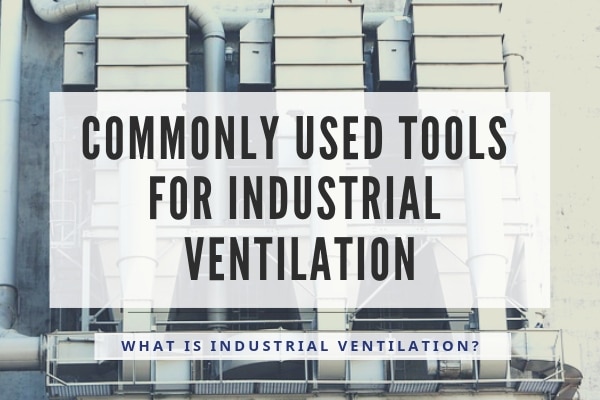
What is Industrial Ventilation?
Industrial ventilation is a mechanical system that brings in fresh outdoor air into the workplace (factory or manufacturing plant) and removes contaminated indoor air. Ventilation is used in a factory to provide a healthy and safe working environment for employees and to remove or have control over contaminants released in an indoor work environment. The ventilation could be achieved by opening a window (natural) or using fans/blowers (mechanical means). Common pollutants that are removed using an industrial ventilation system include: flammable vapors, welding fumes, dust, mold, asbestos fibers, oil mists, toxic chemicals, moisture and more.
Installing proper industrial ventilation is crucial for providing a safe and healthy environment for workers. They are critical to monitoring indoor air quality. A well-designed ventilation system will bring the air into the workspace at a specific speed creating the required air pressure to ensure cost savings for heating and cooling.
The purposes of a well designed industrial ventilation system are:
- Provide a continuous supply of fresh outside air
- Maintain temperature and humidity
- Reduce hazards for fire and explosion
- Remove or dilute contaminants in the air
An industrial ventilation system consists of two subsystems: the fresh air supply and an exhaust system.
The fresh air supply system includes an air inlet, air filtering equipment, heating and/or cooling equipment, fans, ductwork and air distribution registers.
The exhaust system has an air intake area and ducts to remove contaminated air from one area to another area, an air cleaning device, discharge stacks and fans.
Limitations of Industrial Ventilation Systems
Some limitations of many if not all industrial ventilation systems:
- They require ongoing maintenance because of contaminant build-up within the system, especially filters.
- Regular and routine testing is needed to identify problems early and implement corrective measures.
- Only qualified persons should make modifications to a ventilation system to make sure the system continues to work effectively.
- Making unauthorized changes to the duct system will pull air into the system from the new location resulting in reduced air flow from other locations. The entire ventilation system airflow will be affected resulting in rapid plugging of the system preventing the system from adequately removing contaminants.
Types of Industrial Ventilation Systems
There are three types of industrial ventilation systems: Dilution, Local Exhaust, and Indoor air quality ventilation
Dilution System
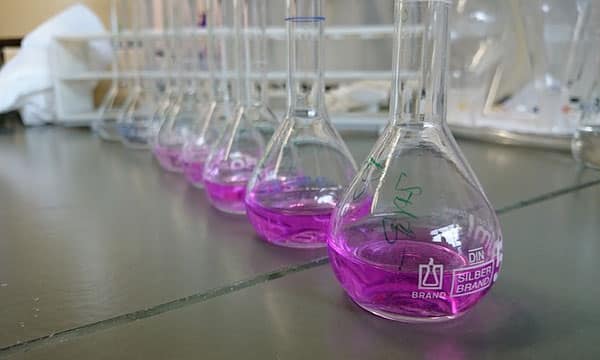
A Dilution system reduces the number of contaminants in the air by mixing the contaminated air with clean, fresh air. To install a dilution system, large exhaust fans are installed in the walls or the roof of a factory. This type of industrial ventilation system is used when:
- Air pollution is low and toxicity level is low to moderate.
- Contaminants are vapours or gases
- Emissions are uniform and widely dispersed
- Recommended for moderate climatic environments
- Heat is removed by flushing to the outside
- Mobile contaminant sources are controlled
Advantages of Dilution:
- Needs less maintenance.
- Lower equipment and installation costs
- Recommended for small amounts of low toxic chemicals
- Effectively controls flammable or combustible gases or vapors
- Used for mobile or dispersed contaminant sources
Disadvantages of Dilution:
- Not recommended for highly toxic chemicals
- Does not completely remove contaminants so it is not recommended for high concentrations of dust, fumes, gases, or vapors
- Large quantities of heated or cooled makeup air is required.
- Not recommended for irregular emissions of contaminants.
What is Make up air?
Make up air is the air used to replace the air that was extracted from the workplace. If not replaced, the workplace could become “starved” of air and result in negative air pressure. The negative air pressure could increase resistance on the ventilation system resulting in less air being moved. To determine the pressure in a workplace:
- Open a door 3 mm and hold a smoke tube in front of the opening. If the smoke is drawn into the room, the room has negative pressure. If the smoke is pushed away from the room the room has positive pressure. If the smoke raises straight into the air, then the pressure in the room is the same as the outside pressure.
- Check the resistance when pushing or pulling a door.
- If the room has a negative pressure – an easy solution is to install a separate intake fan, located away from the exhaust fans to bring fresh uncontaminated air from the outside. Ideally, the air is clean and warmed in the winter or cooled in the summer; as needed. Check some common questions and optimal placement of intake fan here (What are the main features of dilution ventilation?).
Local Exhaust System
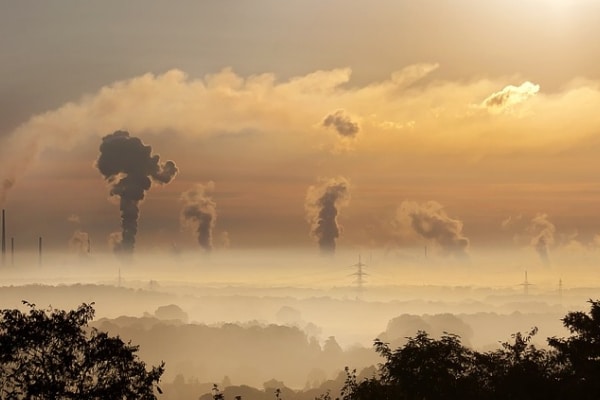
A Local Exhaust system captures contaminants at the source and ejects them outside. It functions on a principal that air moves from high pressure areas to low pressure areas. This difference in pressure is created by a fan that draws air through the ventilation system.
This system is used in areas of high air contamination concentration where there is a greater risk to of exposure to employees. The ventilation system is used for isolated or contaminant sources. This system requires:
- A hood or other device to capture the air pollutants at the source.
- Ductwork as close to the source of contaminants as possible to move the contaminants away from the inside. The material must be compatible with the airstream
- A quality air filter system to clean the air as it moves.
- A fan that moves the air through the system and blows it outdoors
- A stack through which the contaminants are removed.
- The workers are considered in the design, installation, and maintenance of this system.
NOTE: The fan must be the proper type, wheel, arrangement, and size for the application. The fan may require spark resistant construction or other special options.
This system can handle removing many kinds of pollutants including metal fumes and dust. It uses less energy than dilution systems. This type of industrial ventilation system is used when:
- Inconsistent emissions over time
- High concentration of hazardous materials
- Point sources of contaminants
- Workers are close to the source of contaminants
- Factory is in a severe climate location
- It is required not to turnover air in the factory
Advantages of a Local Exhaust Ventilation System:
- Requires less makeup air because less quantities of air are exhausted
- Reduced energy heating and cooling costs
- Captures the emission at the source and removes it
- The best type of ventilation for highly toxic airborne contaminants, fumes, gases, vapours, and dust.
Disadvantages of a Local Exhaust Ventilation System:
- High cost to design, install, and maintain
- Requires regular maintenance, inspection, and cleaning
Indoor Air Quality Ventilation
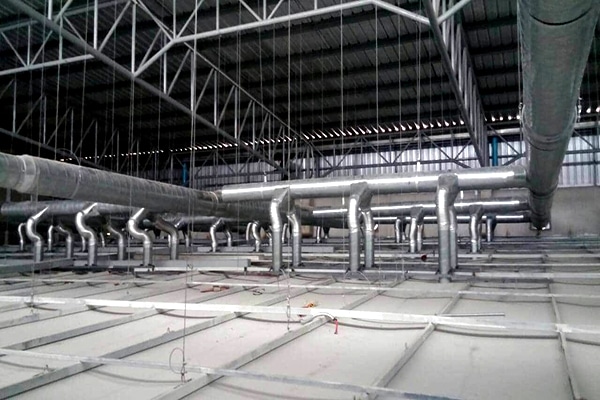
Indoor air quality ventilation, which provides fresh heated or cooled air to buildings as part of the heating, ventilating and air-conditioning system (HVAC). The parts of an HVAC system include:
- Air inlet
- Air filtering equipment
- Heating/cooling equipment
- Fan
- Ducts
- Air distribution registers
The exhaust system consists of:
- Air intake area
- Ducts to move air from one area to another
- Air cleaning device
- Fans to bring the outside air in the factory and to bring contaminated indoor air outside
- Stacks
Nex Flow® Venting Solution
- Fume and Dust extractors
- Ring Vac®
- Air Volume amplifiers
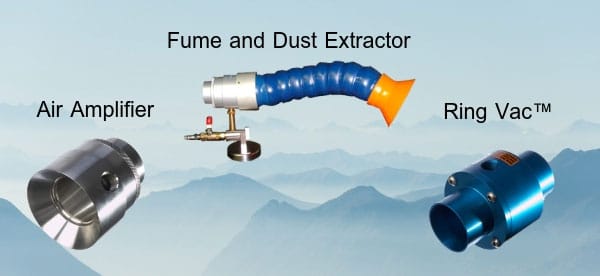
Fume and Dust Extraction system is designed for portable use, especially for intermittent (on- off) applications. They are rugged and long lasting. This option is beneficial because of its low cost with reduced noise. For soldering applications, spot welding operations, a small, portable less expensive unit using a small amount of compressed air is more cost efficient than a heavier electronically operated unit.
The system is Low cost and durable and consists of:
- An adjustable air amplifier
- 2” lock-line hose, which draws in a large volume
- Magnetic base – which secures to a metal working table
- A hose can be clamped onto the outlet of the amplifier to take the fumes and dust into a container or out to another area.
Ring Vac® may be added and used to convey collected material beyond 10 feet (3 meters). The Model 40002FMS Stream Vac® (link to product) is affordable compact air cleaning system to remove dust, fumes, and other air pollution from work places. When connected to 10 feet (3 meters) 2” hose compressed air line, the system will remove up to several hundred cubic feet of air with welding and soldering fumes, particulate from local grinding operations, smoke and particulate using very little compressed air.
Air Amplifiers also called “Air Movers” – can be used for moving a large volume of air. Air Amplifiers uses a small parcel of compressed air to produce high velocity and volume, low pressure air flow as the output. They are ideal blowing or cooling and for venting. Air amplifiers are used to convey powders and dust, exhaust tank fumes, and moves air 12 to 20-fold in duct appliances to 60 times in area with no ducts. The amplifiers use a small amount of compressed air to draw in a flow of up to 17 times the air consumed to remove fumes quickly and efficiently for venting applications. The fumes can be ducted away, up to 50 feet (15.24 m), and the amount of suction and flow is easily controlled.
If a large amount of air borne dust or fumes need to be collected and moved a long distance, the air amplifier enhances the air conveyor ability to convey these materials over long distances. The reason is that air conveyors produces high vacuum but move less volume as compared to air amplifiers that move high volume but creates less vacuum. Nex Flow air conveyor systems are manufactured in anodized aluminum for most applications and in 304 Stainless Steel for high temperature and corrosive environments. 316L Stainless Steel air operated conveyors are available for food and pharmaceutical applications. An XSPC range conveyor is also available for moving materials that could clog. Air Amplifiers are lightweight, compact and portable so any application where that can be an advantage is ideal for their use, especially if the use is intermittent minimizing the real energy cost of compressed air.
The following accessories are available with Nex Flow air amplifiers:
- Hose or pipe to collect or transfer materials, fumes, and dust
- Filters
- Mounting systems including brackets
- Regulators
- PLCFC
- Stainless steel shims for maximum product lifespan
- Pneumatic water separator
- Manual valves
- Replacement parts
- Flanges
NOTE: Pipes reduce the air amplification by 10:1 due to back pressure but still provides more efficient air amplification because venture systems move air or vent gas.
Nex Flow air amplifiers are compressed air operated devices that are often used for local ventilation due to their portability. They are not electrically run so there is no explosion risk. Compact and rugged, they are built to last. If existing systems are not sufficiently strong enough to move the contaminated air, then Air Amplifiers can boost these systems and overcome the losses. This deficiency may be caused by a pressure drop at ventilation entrances.
Filtration is important for maintaining the effective and optimum operation of all Nex Flow air operated products. All Next Flow products used for conveying. such as air amplifiers, air operated conveyors, etc. require clean compressed air. It is essential to use filters to remove water and oil from the compressed air lines. These filters are installed upstream from the air amplifier or air mover in the industrial ventilation system. Air filters should be sized to handle the maximum air flow expected for conveying the contaminated or clean air they are moving. Nex Flow water and oil removal filters are 5 microns and 0.3 microns respectively.
Best Practices for After Installation
It is important to follow through with your employees and train them on the industrial ventilation system. They should be aware of the following:
- How the exhaust system is designed and the intended use.
- The use of the flow restrictors, diverters, and baffles that can alter air movement.
- Keep all hoods, slots, and duct work openings clear of debris, obstructions and buildup which reduces the amount of air entering the ventilation system
- The ideal location to position the employee and the equipment to maximize the amount of air movement into the exhaust hood.
- Employees should continuously observe the ventilation system for damage and flow restrictions. They should be aware of who to report damages to. A manometer, used to monitor pressure, is a good method of judging if the system require maintenance.
- An employee should perform regular system maintenance, such as changing filters. This will reduce the amount of resistance in the system and improves the systems efficiency.
What does all this mean?
It is important to properly design your industrial ventilation system to achieve the following:
- Provide continual fresh air supply
- Protect workers from heat stroke or cold temperatures
- Reduce fire or explosion risks
- Reduce exposure to airborne contaminants
Although all ventilation systems consist of the same basic principals, each system is designed specifically to meet the requirements of the work environment including the type of work and the rate of contamination release in the factory. Some important standards and items to consider when designing an industrial ventilation system are:
- OSHA and EPA regulations
- Proper duct design
- Air sampling
- Types of materials used in the construction of the system
- Hazard reduction
- Administrative controls
- Efficient hood design
- Proper fan selection
- Fire and explosion hazards
- Pollution control equipment selection
Our experts at Nex Flow® can help you choose the industrial ventilation system best suited for your manufacturing site or factory. Please don’t hesitate to contact us for more information about our ventilation solutions from a simple Air Amplifier to our Ring Vac® and Fume and Dust Extractor.





